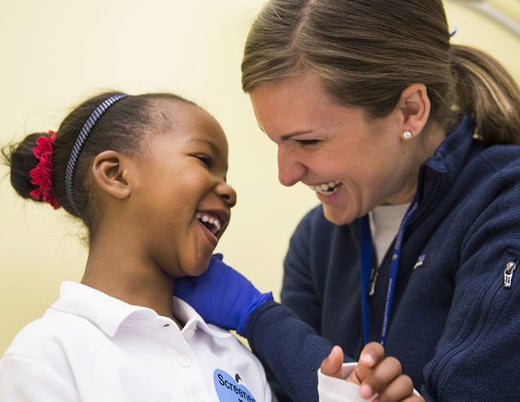Key takeaways
-
Survival for children needing LT for HB is overall very good.
-
Outcomes for salvage transplant in HB were significantly better than expected.
-
Outcomes were less favorable for children with HCC but may be acceptable when comparing to the likelihood of survival without transplant.
-
Thoughtful patient selection is key to distinguish among potentially resectable tumors.
-
There is a need for advocacy for patients with unresectable tumors to receive LT.
Background: The impact of factors specific to liver transplantation on liver cancer survival is poorly understood
Outcomes for 5-year survival after pediatric liver transplantation (LT) for primary hepatic cancer have improved, as evidenced by data reported in 2017 by United Network for Organ Sharing (UNOS) and Scientific Registry of Transplant Recipients (SRTR):

While the survival data is encouraging, knowledge gaps exist regarding specific complications and risk factors for poor outcomes from LT for pediatric liver tumors.
The Children’s Hepatic Tumors International Collaboration (CHIC) identified these negative predictors for event-free survival (EFS) in HB:
- Advanced pretreatment extent of disease (PRETEXT)
- Age 8 years or older
- Alpha fetoprotein (AFP) less than 100ng/ml
- Macrovascular venous/portal involvement
- Contiguous extrahepatic disease
- Tumor multifocality or rupture
- Metastatic disease
LT as a risk factor was not evaluated, so its impact on the five-year survival of patients with HB and pediatric HCC is poorly understood.
Researchers in the Pediatric Liver Center at Children’s Hospital Colorado led this multi-institutional study to explore predictors for graft and patient survival and assess postoperative complications using the Society of Pediatric Liver Transplantation (SPLIT) database.
Methods: Liver transplant data was collected and reviewed
Study authors reviewed observational, longitudinal data from children who had LT for HB or HCC at more than 40 pediatric centers in the United States and Canada between January 2011 and September 2019.
Outcomes evaluated
- Event Free Survival (EFS: survival without retransplant or tumor recurrence)
- Short-term outcomes (intubation time, length of stay, reoperation, readmission)
- Long-term outcomes (vascular and biliary complications, infections, rejection, renal injury)
HB-specific data
- Pretreatment extent of disease (PRETEXT I-IV)
- Post-treatment extent of disease (POST-TEXT I-IV)
- Distant metastatic disease (M)
- Vascular invasion of three hepatic veins or the vena cava (V)
- Vascular invasion of portal bifurcation or portal vein (P)
- Tumor histology
- Alpha fetoprotein (AFP) at diagnosis and prior to transplant
- Number of chemotherapy cycles before (neoadjuvant) and after (adjuvant) transplant
HCC-specific data
- Presence of cirrhosis
- Tumor size and distribution from explant pathology
Other data
- Patient age
- Donor/graft type
- Waitlist time
- Center size
- Sirolimus (mTOR inhibitor) use for post-transplant immunosuppression
Center-specific data were collected from 16 centers with the highest volume of HB and HCC transplants.
Results: comparing outcomes of liver transplant for tumors versus non-tumors
There were 2,424 patients in the SPLIT database during the study period. Researchers excluded patient data from LTs performed for other tumor indications.
Among all patients who received a LT for HB
- 205 total patients
- 157 (77%) from the 16 largest centers used in the analysis
- 13 salvage transplants (LT occurring after prior tumor resection and subsequent recurrence in the remaining liver) were excluded from the analysis of tumor extent and AFP
- Center size
- 57.1% at large centers
- 29.3% at medium centers
- 13.6% at small-medium centers
- Patient characteristics
- 3.2 years average age
- 1.2-month average waitlist
- 3.8% received living donor
- Tumor metastasis
- 26 (18.3%) tumor metastasis at diagnosis
- 6 (4.2%) tumor metastasis following chemotherapy
- 5 pulmonary metastasis (resected mean of 39.4 days before transplantation)
- 1 omental metastasis (resected at transplantation)
- Vascular invasion
- 79 (54.9%) had vascular invasion at diagnosis
- 63 (43.8%) had vascular invasion following chemotherapy
- Survival data
- 86% 5-year patient survival
- 82% 5-year graft survival
- PRETEXT stage
- 10 (6.9%) stage 2
- 50 (34.7%) stage 3
- 81 (56.3%) stage 4
- 3 missing data
- POST-TEXT stages
- 2 (1.4%) stage 1
- 20 (13.9%) stage 2
- 62 (43.1%) stage 3
- 53 (36.8%) stage 4
- 6 missing data
- EFS
- 81% at 3 years post-transplant
- 67% EFS for age 8 years and older
- 82% EFS for younger than 8 years old
- 77% at 5 years post-transplant
- 53% EFS for age 8 years and older
- 79% EFS for younger than 8 years old
- Metastatic disease at diagnosis did not affect EFS
- 78% EFS with no metastases post-chemotherapy
- 75% EFS with residual metastases post-chemotherapy
- Sirolimus use did not affect EFS
- EFS was similar for salvage transplant as compared to primary LT
- 85% EFS for salvage LT
- 87% EFS for primary LT
- 5 of 30 retransplants, others patient death or tumor recurrence
- 4.8 average cycles of neoadjuvant chemotherapy
- Number of cycles did not affect EFS
- Time between chemotherapy and LT did not affect EFS
- 2.2 average cycles of adjuvant chemotherapy
- More cycles predicted worse EFS, likely due to tumor recurrence
- Time between LT and chemotherapy did not affect EFS
- 81% at 3 years post-transplant
- AFP
- Level at diagnosis did not affect survival rate
- Log-fold AFP change in response to chemotherapy was higher in survivors
- Larger log-fold AFP decrease predicted better EFS
- An AFP greater than 100ng/ml at two to four months post-transplant was associated with poor one-year EFS
Data for patients who received a LT for HCC
- 27 total patients
- 18 (67%) from the 16 largest centers used in the analysis
- Center size
- 50% at large centers
- 50% at medium centers
- Patient characteristics
- 9.5 years average patient age
- 1.1-month average waitlist
- 16.7% received a living donor
- 66.7% were beyond Milan criteria on explant pathology
- 44.4% had underlying cirrhosis
- Survival data
- 75% 5-year patient survival
- 71% 5-year graft survival
- EFS
- 62% EFS at 3- and 5-years post-transplant
- 1/6 had re-transplantation, the rest were patient death or tumor recurrence
- Older age predicted worse EFS
- Children 8 years and older: 57% 1-year and 38% 3-year EFS
- Children less than 8 years: 86% 1-year and 3-year EFS
- EFS not affected by graft or donor type
- More extensive tumors had worse EFS:
- Tumors within Milan criteria: 83% 3-year EFS
- Tumors outside Milan criteria: 48% 3-year EFS
- Tumors arising in non-cirrhotic liver had worse EFS:
- Tumors in non-cirrhotic liver: 48% 3-year EFS
- Tumors in cirrhotic liver: 75% 3-year EFS
For patients receiving a LT for non-tumor indications
- 2,165 total
- 1,913 used in analysis
- 205 excluded for LT for acute liver failure
- Patient characteristics
- 19.6% received a living donor
- 96% 5-year patient survival
- 92% 5-year graft survival
Of the 36 patient deaths among tumor transplants, 72.7% were from recurrence of malignancy.
Discussion: Outcomes for liver transplants for tumors are comparable to non-tumors
Researchers found the effect of tumor burden on HB outcome after liver transplant did not affect survival.
Survival rates were comparable between:
- PRETEXT III and IV tumors after LT
- Patients with residual and no metastasis
Observations
- Surprising number of LT for PRETEXT II and POST-TEXT I-II tumors
- Tumors which would typically be thought amenable to surgical resection should not undergo transplant, both to reduce the morbidity and mortality associated with transplant and to preserve scarce organs for those in need.
- Updated guidelines, access to specialist in aggressive resection and transplantation will preserve livers for those most in need
- LT only treatment option for children with truly unresectable liver tumors
- Enrolling all patients in combined chemotherapy/surgical protocol may ensure equitable LT distribution
Conclusion: Survival data supports liver transplantation to treat advanced hepatoblastoma and hepatocellular carcinoma
- Survival for children needing LT for HB is overall excellent
- Outcomes for salvage HB transplant were significantly better than expected
- Outcomes are less favorable for children with HCC, but may be acceptable when comparing to the low likelihood of survival without transplant
These results provide data supporting a need to preserve LT for children without viable treatment options and to offer these children LT as an option even if survival is lower than LT for non-tumors. Excluding liver transplant patients from the Scientific Registry of Transplant Recipients outcomes may encourage life-saving transplant in pediatric patients with HB and HCC.
Featured Researchers

Mark Lovell, MD
Pediatric pathology specialist
Pathology and Laboratory Services
Children's Hospital Colorado
Professor
Pathology
University of Colorado School of Medicine

Jonathan Roach, MD
Pediatric surgeon
Center for Children's Surgery
Children's Hospital Colorado
Associate professor
Surgery-Peds Surgery
University of Colorado School of Medicine

Shikha Sundaram, MD
Medical Director, Liver Program
Gastroenterology and Transplant Hepatology
Children's Hospital Colorado





 720-777-0123
720-777-0123











